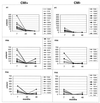Cell-mediated immune responses in four-year-old children after primary immunization with acellular pertussis vaccines
- PMID: 10417175
- PMCID: PMC96703
- DOI: 10.1128/IAI.67.8.4064-4071.1999
Cell-mediated immune responses in four-year-old children after primary immunization with acellular pertussis vaccines
Abstract
Cell-mediated immune (CMI) responses to Bordetella pertussis antigens (pertussis toxin [PT], pertactin [PRN], and filamentous hemagglutinin [FHA]) were assessed in 48-month-old recipients of acellular pertussis [aP] vaccines (either from Chiron-Biocine [aP-CB] or from SmithKline Beecham [aP-SB]) and compared to CMI responses to the same antigens at 7 months of age, i.e., 1 month after completion of the primary immunization cycle. None of the children enrolled in this study received any booster of pertussis vaccines or was affected by pertussis during the whole follow-up period. Overall, around 75% of 4-year-old children showed a CMI-positive response to at least one B. pertussis antigen, independently of the type of aP vaccine received, and the proportion of CMI responders were at least equal at 48 and 7 months of age. However, longitudinal examination of individual responses showed that from 20 (against PT) to 37% (against FHA) of CMI responders after primary immunization became negative at 48 months of age. This loss was more than compensated for by conversion to positive CMI responses, ranging from 36% against FHA to 69% against PRN, in other children who were CMI negative at 7 months of age. In 60 to 80% of these CMI converters, a lack of decline or even marked elevation of antibody (Ab) titers against B. pertussis antigens also occurred between 20 and 48 months of age. In particular, the frequency of seropositivity to PRN and FHA (but not to PT) was roughly three times higher in CMI converters than in nonconverters. The acquisition of CMI response to B. pertussis antigens in 48-month-old children was not associated with a greater frequency of coughing episodes lasting >/=7 days and was characterized by a prevalent type 1 cytokine profile, with high gamma interferon and low or no production of interleukin-5, reminiscent of cytokine patterns following immunization with whole-cell pertussis vaccine or natural infection. Our data imply that vaccination-induced systemic CMI may wane by 4 years of age but may be acquired or naturally boosted by symptomless or minor clinical infection by B. pertussis. This might explain, at least in part, the persistence of protection against typical pertussis in aP vaccine recipients despite a substantial waning of both Ab and CMI responses induced by the primary immunization.
Figures




References
-
- Ad Hoc Group for the Study of Pertussis Vaccines. Placebo controlled trial of two acellular pertussis vaccines in Sweden; protective efficacy and adverse events. Lancet. 1998;ii:955–960. - PubMed
-
- Ausiello C M, la Sala A, Ramoni C, Urbani F, Funaro A, Malavasi F. Secretion of IFN-γ, IL-6, granulocyte-macrophage colony-stimulating factor and IL-10 cytokines after activation of human purified T lymphocytes upon CD38 ligation. Cell Immun. 1996;173:192–197. - PubMed
-
- Ausiello C M, Lande R, la Sala A, Urbani F, Cassone A. Cell-mediated immune response of healthy adults to B. pertussis vaccine antigens. J Infect Dis. 1998;178:466–470. - PubMed
Publication types
MeSH terms
Substances
Grants and funding
LinkOut - more resources
Full Text Sources
Other Literature Sources
Molecular Biology Databases

